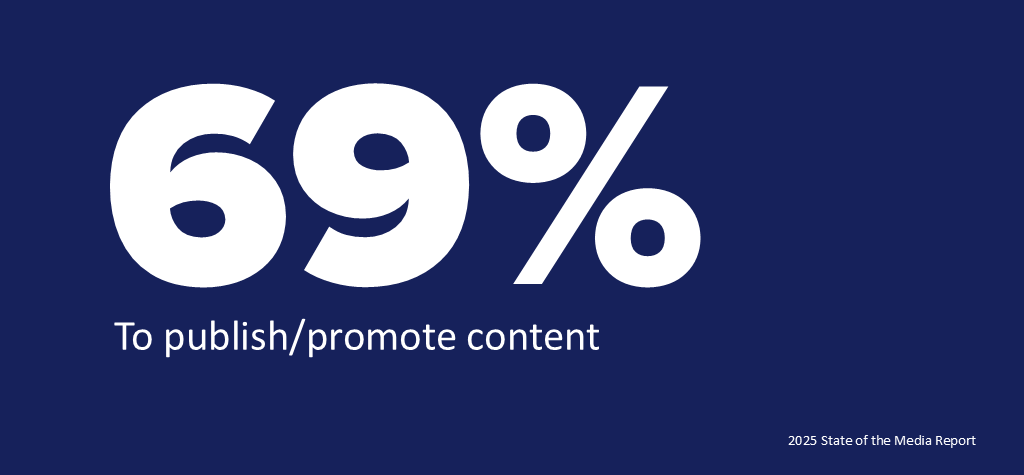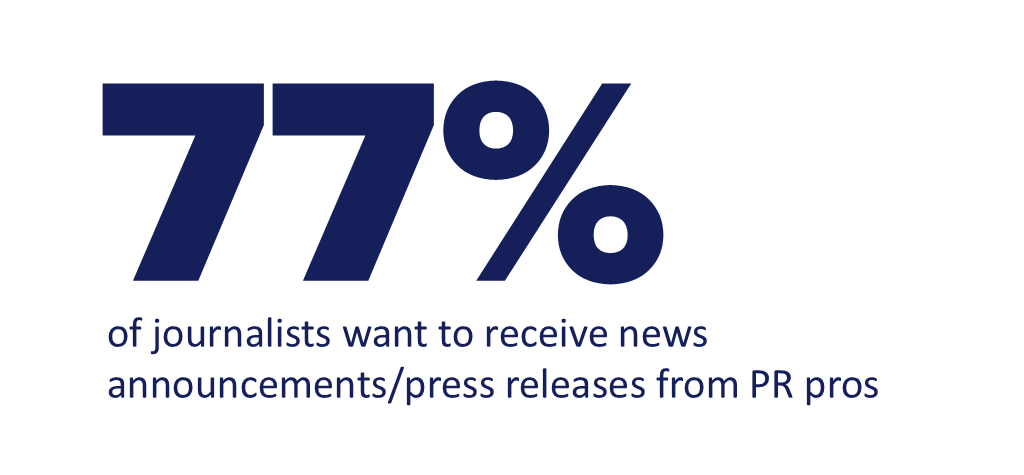The tech industry never seems to sleep, meaning PR teams who support tech industry brands or organizations must work hard to keep up. While product teams are working to improve AI-powered features (including our own teams!) and software engineers are building the next generation of machine learning algorithms, PR and communications professionals are trying to improve their media relations strategies and get tech journalists to notice their brand’s stories.
But how can you break through the noise and get the attention of journalists covering one of the most competitive and fast-moving industries?
There’s not a single answer to this question, but rather a multitude of answers that can help you understand exactly what tech journalists want. Thanks to the 2025 State of the Media, a survey of almost 600 tech reporters and over 3,000 journalists from different industries in total, we have the insider intel that can help you craft effective pitches and earn more media coverage.
Use these exclusive insights to learn how to make your pitches stand out, how to increase the chances of getting coverage, and how to build relationships with tech reporters that lead to ongoing coverage.
Inside the Minds of Technology Reporters
If you want to build strong relationships with tech journalists, you need to understand what makes them tick. That begins with understanding their top challenges (both in their industry and individually).
According to our findings, the biggest challenge tech journalists face in 2025 is “adapting to changing audience behaviors around media consumption,” followed by “maintaining credibility as a trusted news source,” and “declining advertising and circulation rates.”
What do you believe were the biggest challenges for journalism in the last year?
44% - Adapting to changing audience behaviors around media consumption
39% - Maintaining credibility as a trusted news source/combating accusations of “fake news”
37% - Declining advertising and circulation revenues
32% - The emergence of AI
Knowing where journalists are struggling enables you to approach them with a sense of empathy and do your best to help them navigate these challenges (and the easier you make their lives, the more they’ll want to partner with you). For example, knowing that they’re working with limited resources and fighting to maintain audiences’ attention, proactively offer up some multimedia assets (images, videos, etc.) they can use to supplement their coverage and increase audience engagement.
Another thing to know about tech journalists: They depend heavily on social media for nearly every aspect of their jobs. According to our research, they use social media in their day-to-day lives: 96% of them told us they use it for work-related purposes – from publishing or promoting content to keeping up with trending topics.

In the last year, have you used social media for any of the following work-related reasons?
69% - To publish/promote content
57% - To interact with my audience
55% - To network
52% - To pick up on trending topics
Note that “receiving PR pitches” is not one of the top options, so you shouldn’t DM journalists to pitch your story unless you already have an established relationship. Ninety-eight percent of tech reporters want to receive your pitches via email. Needless to say, you shouldn’t use social media to follow up on a pitch either.
Understanding the ways in which journalists use different platforms should help you adapt your outreach strategy and tailor your approach accordingly. For example, you might want to use visual content for Instagram-active journalists but focus on relationship-building through LinkedIn engagement. As journalists adapt to new platforms and formats, you should also stay current with these changes so you can effectively engage with them.
What Do Tech Reporters Want From Public Relations Professionals?
This is not a guessing game: We asked, and they answered. Tech journalists say the content they want most from PR professionals are news announcements or press releases (cited by 77% of respondents); but a majority of them (63%) also want exclusives for stories, and nearly the same number (61%) want original research reports (such as trends or market data). It’s easier to build a long-lasting relationship with tech reporters once you establish yourself as a valuable resource by delivering exactly what they expect.
 What kind of content or information do you most want to receive from public relations professionals?
What kind of content or information do you most want to receive from public relations professionals?
- 77% - News announcements/press releases
- 63% - Exclusives for stories
- 61% - Original research reports (trends, market data, etc.)
- 49% - Interviews with industry experts
If you really want to impress tech journalists, here’s what they think the ideal pitch should include: 61% would prefer your pitch to include compelling data or statistics (which aligns with them asking for original research), while 50% would consider covering your story if it has a unique angle or point of view. And although it might seem like an obvious thing to include, don’t forget to provide contact information (nearly half of the respondents chose this as an important element for the ideal pitch).
Another factor that could sway journalists: Multimedia. Not only do 40% of journalists consider an ideal pitch one that includes multimedia, over 90% used PR-provided multimedia in their coverage last year. This indicates that journalists have an appetite for audio or visual elements that can add needed context and originality to their storytelling.
When asked whether they’re more likely to pursue a pitch if it has multimedia elements, for 40% it makes no difference, while 39% said that it depends on the type of multimedia. However, if you want to include assets, their top choices are: Images (76%), data visualization or infographics (43%), and videos (34%). Remember that when adding multimedia elements, these should support the story, resonate with their audiences, and be appropriate for specific platforms.
What NOT to Do When Pitching Tech Reporters
Knowing what tech journalists want from you is important. But knowing what they don’t want is equally crucial.
Spamming them with irrelevant pitches is a sure-fire way of getting on their blacklist: 79% of tech journalists feel this way. Relevance plays one of the biggest roles in effective PR pitching. Before you click “Send”, think twice about their coverage area, their beat, and their audiences. Ensure the information you provide is accurate and you have data or industry experts to back it up. Irrelevance is not the only red flag for journalists – avoid these other outreach tactics, which can break relationships before they even start.

What would make you block a PR professional or put them on your “don’t call” list?
- 79% - Spamming me with irrelevant pitches
- 59% - Pitches that sound like marketing brochures
- 58% - Providing inaccurate or unsourced information
- 54% - Following up with me repeatedly
Another area where tech journalists can have strong opinions: The follow-up to your pitch. Knowing when to follow up can have a big impact on your relationship with tech reporters: 1 in 2 journalists will block a PR pro who follows up repeatedly. It is recommended that you only follow up once (63% of them support this), however some of them (27%) don’t want you to follow up at all. As these findings indicate, feelings on the subject are wide-ranging, and each journalist is different. The more you get to know their unique preferences, the more fruitful your interactions will be.
How to Win Favor With Tech Reporters
Getting journalists to cover your story once shouldn’t be your only goal; you should find ways to build a relationship with them that can prove to be beneficial over time. Helping them overcome their own challenges and providing value up front are great places to start, as they build trust and credibility. Here’s how you can support them:
In your experience, what are some of the ways PR professionals provide value?
67% - They connect me with relevant resources
65% - They facilitate access to key people or places
47% - They provide relevant story ideas
47% - They give me access to exclusive news or content
Remember: When journalists know they can rely on you for support, valuable intel, and resources when they need it, they more they are likely to want to partner with you – again and again.
For more ways of winning favor with journalists, check out our tip sheet, How to Become Journalists’ Favorite PR Pro, and learn how to stand out.
How to Identify the Right Journalists for Your Tech Pitch
Now you know how to pitch (you can check out The Complete Guide to PR Pitching for further insights and practical tips) but knowing who to pitch is equally important. Your pitching strategy should include identifying the right reporters, which is a major challenge for many PR teams, according to the 2025 Comms Report.
We recommend using a high-quality media database, which can help you search top outlets and journalists who not only cover the tech industry, but also discuss trends and topics related to it. With this type of platform, you can also find valuable information on their profiles, helping you personalize your pitches, such as out which outlets they work for, topics of interest, and most recent work.
Want to see how it works? Check out CisionOne's suite of solutions by requesting a demo.
Most Recent Posts
Cision Resources
-
E-books and Guides
Comprehensive how-to guides on strategy and tactics
-
Case Studies
What are other brands doing – and how can we learn from them?
About Bianca Parvu
Bianca is the Junior Copywriter at Cision, specializing in tech industry storytelling. She crafts engaging content across digital channels, from thought leadership to email marketing campaigns.
Learn More. Do More. demo new
PR Tips, Case Studies, and Product Updates

[On-Demand Webinar] The Next Generation of Media Intelligence: From Gorkana to CisionOne
Explore CisionOne, a revolutionary media intelligence platform, and the evolution of Gorkana. Learn key features and strategies from Luke Williams, CisionOne Product Marketing Manager. Elevate your media outreach to new heights!


